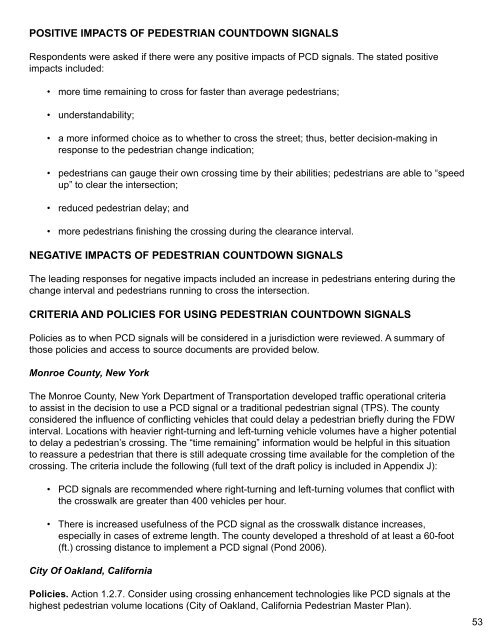Pedestrian Signal Safety - AAA Foundation for Traffic Safety
Pedestrian Signal Safety - AAA Foundation for Traffic Safety
Pedestrian Signal Safety - AAA Foundation for Traffic Safety
You also want an ePaper? Increase the reach of your titles
YUMPU automatically turns print PDFs into web optimized ePapers that Google loves.
POSITIVE IMPACTS OF PEDESTRIAN COUNTDOWN SIGNALS<br />
Respondents were asked if there were any positive impacts of PCD signals. The stated positive<br />
impacts included:<br />
• more time remaining to cross <strong>for</strong> faster than average pedestrians;<br />
• understandability;<br />
• a more in<strong>for</strong>med choice as to whether to cross the street; thus, better decision-making in<br />
response to the pedestrian change indication;<br />
• pedestrians can gauge their own crossing time by their abilities; pedestrians are able to “speed<br />
up” to clear the intersection;<br />
• reduced pedestrian delay; and<br />
• more pedestrians finishing the crossing during the clearance interval.<br />
NEGATIVE IMPACTS OF PEDESTRIAN COUNTDOWN SIGNALS<br />
The leading responses <strong>for</strong> negative impacts included an increase in pedestrians entering during the<br />
change interval and pedestrians running to cross the intersection.<br />
CRITERIA AND POLICIES FOR USING PEDESTRIAN COUNTDOWN SIGNALS<br />
Policies as to when PCD signals will be considered in a jurisdiction were reviewed. A summary of<br />
those policies and access to source documents are provided below.<br />
Monroe County, New York<br />
The Monroe County, New York Department of Transportation developed traffic operational criteria<br />
to assist in the decision to use a PCD signal or a traditional pedestrian signal (TPS). The county<br />
considered the influence of conflicting vehicles that could delay a pedestrian briefly during the FDW<br />
interval. Locations with heavier right-turning and left-turning vehicle volumes have a higher potential<br />
to delay a pedestrian’s crossing. The “time remaining” in<strong>for</strong>mation would be helpful in this situation<br />
to reassure a pedestrian that there is still adequate crossing time available <strong>for</strong> the completion of the<br />
crossing. The criteria include the following (full text of the draft policy is included in Appendix J):<br />
• PCD signals are recommended where right-turning and left-turning volumes that conflict with<br />
the crosswalk are greater than 400 vehicles per hour.<br />
• There is increased usefulness of the PCD signal as the crosswalk distance increases,<br />
especially in cases of extreme length. The county developed a threshold of at least a 60-foot<br />
(ft.) crossing distance to implement a PCD signal (Pond 2006).<br />
City Of Oakland, Cali<strong>for</strong>nia<br />
Policies. Action 1.2.7. Consider using crossing enhancement technologies like PCD signals at the<br />
highest pedestrian volume locations (City of Oakland, Cali<strong>for</strong>nia <strong>Pedestrian</strong> Master Plan).<br />
53








